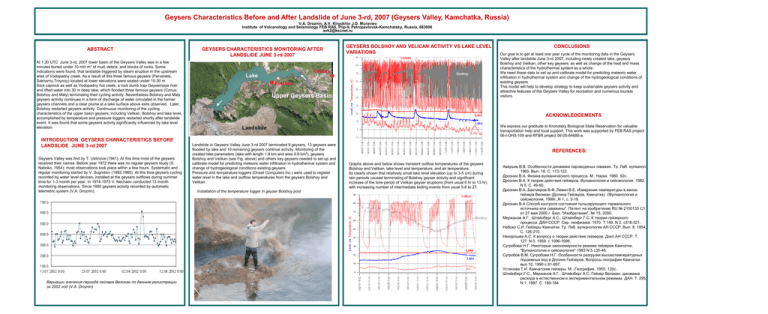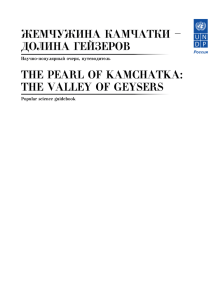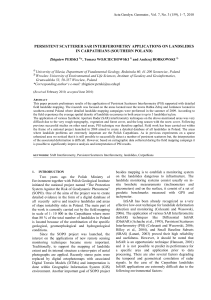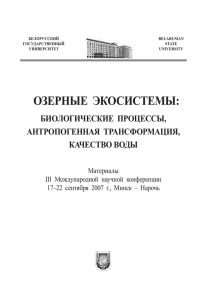Ppt-3-14
реклама

Geysers Characteristics Before and After Landslide of June 3-rd, 2007 (Geysers Valley, Kamchatka, Russia) V.A. Droznin, A.V. Kiryukhin J.D. Muraviev Institute of Volcanology and Seismology FEB RAS, Piip-9, Petropavlovsk-Kamchatsky, Russia, 683006 [email protected] ABSTRACT GEYSERS CHARACTERISTICS MONITORING AFTER LANDSLIDE JUNE 3-rd 2007 At 1:20 UTC June 3-rd, 2007 lower basin of the Geysers Valley was in a few minutes buried under 10 mln m3 of mud, debris, and blocks of rocks. Some indications were found, that landslide triggered by steam eruption in the upstream area of Vodopadny creek. As a result of this three famous geysers (Pervenets, Sakharny,Troynoy) located at lower elevations were sealed under 10-30 m thick caprock as well as Vodopadny hot creek, a rock dumb trap Geysernaya river and lifted water into 30 m deep lake, which flooded three famous geysers (Conus, Bolshoy and Maly) terminating their cycling activity. Nevertheless Bolshoy and Maly geysers activity continues in a form of discharge of water circulated in the former geysers channels and a clear plume at a lake surface above exits observed. Later, Bolshoy restarted geysers activity. Continuous monitoring of the cycling characteristics of the upper basin geysers, including Velikan, Bolshoy and lake level, accomplished by temperature and pressure loggers restarted shortly after landslide event. It was found that some geysers activity significantly influenced by lake level elevation. INTRODUCTION. GEYSERS CHARACTERISTICS BEFORE LANDSLIDE JUNE 3-rd 2007 Geysers Valley was find by T. Ustinova (1941). At this time most of the geysers received their names. Before year 1972 there was no regular geysers study (S. Naboko, 1954); most observations took place within a few hours. Systematic and regular monitoring started by V. Sugrobov (1982,1985). At this time geysers cycling recorded by water level devices, installed at the geysers outflows during summer time for 1-3 month per year. In 1974-1975 V. Nechaev conducted 13 month monitoring observations. Since 1990 geysers activity recorded by automatic telemetric system (V.A. Droznin). Вариации значения периода гейзера Великан по данным регистрации за 2002 год (V.A. Droznin) GEYSERS BOLSHOY AND VELICAN ACTIVITY VS LAKE LEVEL VARIATIONS c a d CONCLUSIONS Our goal is to get at least one year cycle of the monitoring data in the Geysers Valley after landslide June 3-rd 2007, including newly created lake, geysers Bolshoy and Velikan, other key geysers, as well as change of the heat and mass characteristics of the hydrothermal system as a whole. We need these data to set up and calibrate model for predicting meteoric water infiltration in hydrothermal system and change of the hydrogeological conditions of existing geysers. This model will help to develop strategy to keep sustainable geysers activity and attractive features of the Geysers Valley for recreation and numerous tourists visitors. ACKNOWLEDGEMENTS b e Landslide in Geysers Valley June 3-rd 2007 terminated 9 geysers, 13 geysers were flooded by lake and 19 remaining geysers continue activity. Monitoring of the created lake parameters (lake with length 1.8 km and area 0.8 km2), geysers Bolshoy and Velikan (see Fig. above) and others key geysers needed to set up and calibrate model for predicting meteoric water infiltration in hydrothermal system and change of hydrogeological conditions existing geysers. Pressure and temperature loggers (Onset Computers Inc.) were used to register water level in the lake and outflow temperatures from the geysers Bolshoy and Velikan. Installation of the temperature logger in geyser Bolshoy pool f g We express our gratitude to Kronotsky Biological State Reservation for valuable transportation help and local support. This work was supported by FEB RAS project 06-I-ОНЗ-109 and RFBR project 06-05-64688-а. REFERENCES: Graphs above and below shows transient outflow temperatures of the geysers Bolshoy and Velikan, lake level and temperature, and air temperature. Its clearly shown that relatively small lake level elevation (up to 3-5 cm) during rain periods caused terminating of Bolshoy geyser activity and significant increase of the time period of Velikan geyser eruptions (from usual 6 hr to 13 hr) with increasing number of intermediate boiling events from usual 5-6 to 27. Аверьев В.В. Особенности динамики пароводяных скважин. Тр. Лаб. вулканол. 1960. Вып. 18. С. 113-122. Дрознин В.А. Физика вулканического процесса. М., Наука. 1980. 92с. Дрознин В.А. К теории действия гейзеров. Вулканология и сейсмология. 1982. N 5. С. 49-60. Дрознин В.А.,Бахтияров В.Ф.,Левин В.Е. Измерения температуры в ванне гейзера Великан (Долина Гейзеров, Камчатка). //Вулканология и сейсмология, 1999г.,N 1, с. 3-19. Дрознин В.А Способ контроля состояния пульсирующего термального источника или скважины". Патент на изобретение RU № 2150133 С1 от 27 мая 2000 г. Бюл. "Изобретения", № 15, 2000. Мержанов А.Г., Штейнберг А.С., Штейнберг Г.C. К теории гейзерного процесса. ДАН СССР. Сер. геофизика. 1970. T.149. N 2. с318-321. Набоко С.И. Гейзеры Камчатки. Тр. Лаб. вулканологии АН СССР. Вып. 8. 1954. C. 126-210. Нехорошев А.С. К вопросу о теории действия гейзеров. Докл.АН СССР. T. 127. N 5. 1959. с 1096-1098. Сугробова Н.Г. Некоторые закономерности режима гейзеров Камчатки. "Вулканология и сейсмология" 1983 N 5 с35-48. Сугробов В.М. Сугробова Н.Г. Особенности разгрузки высокотемпературных подземных вод в Долине Гейзеров. Вопросы географии Камчатки. вып 10. 1990 с 81-897. Устинова Т.И. Камчатские гейзеры. М., География. 1955. 120с. Штейнберг Г.C., Мержанов А.Г., Штейнберг А.С. Гейзер Великан: динамика расхода в естественном и экспериментальном режимах. ДАН. T. 295. N 1. 1987. С. 180-184





